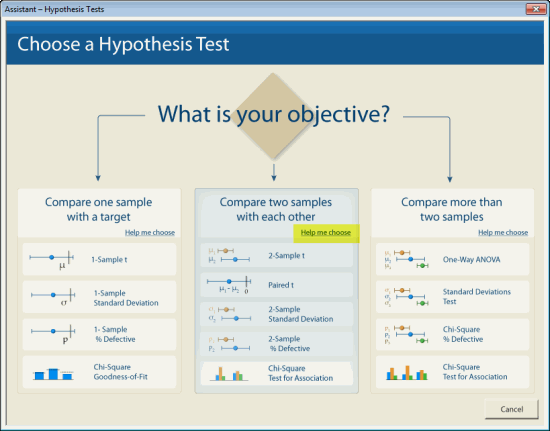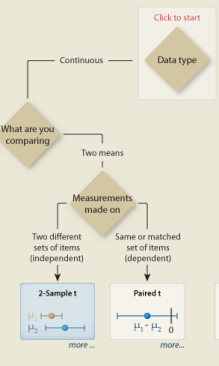So, you collected some data and now you want it to tell you something meaningful. Unfortunately, your last statistics class was years ago and you can't quite remember what to do with that data. You remember something about a null hypothesis and and alternative, but what's all this about testing?
Sometimes it's easier just to give a problem to the Assistant. Especially when it comes to statistics.
Don't get me wrong, I love to analyze data and see what it means...but most of us don't analyze data all day, every day. And in statistics, as in sports, if you don't use it, you lose it. If you haven't done an analysis in months it's not unreasonable to imagine you might need a little help.
In that case, you might seek out the Assistant. Specifically, the Assistant menu in Minitab Statistical Software. The Assistant's always ready to guide you through a difficult statistical task if you're not quite sure what to do.
The 2-Sample t-test
For example, suppose you want to compare two different materials for making backpacks
-
Null hypothesis: H0: m1 - m2 = 0 (strengths of the material from both companies are equal) -
Alternative hypothesis: H1: m1 - m2 ≠ 0 (strengths of the material from both companies are different)
And that if the test's p-value is less than your chosen significance level, you should reject the null hypothesis.
Maybe you're the type of person who remembers all of that stuff, even if you haven't done a t-test in years. If so, good for you–but I could stand to get a little help. Let's see what the assistant can do for me.
The Assistant and the Hypothesis Test
I'll start by pulling up Assistant > Hypothesis Tests... in Minitab. Up comes this dialog box:


Well, I know I have two samples that I want to compare. But I can't remember if I need a paired t-test, a % defective, or what. So I'll click "Help me choose." Now the Assistant gives me an easy-to-follow decision tree that leads me to the 2-sample t-test.
I can follow the tree straight to its conclusion, as shown on the right.
A Guided Path to the Right Hypothesis Test
But if I can't remember enough specifics to follow the decision tree from start to finish from the amount of information shown on the right, the Assistant will actually guide me through the process step-by-step so I arrive safely at the right hypothesis test to use.
In this scenario, The Assistant asks one question, then I choose the right option for my situation and proceed to the next question.
Particularly helpful is the fact that if I forget, for example, the difference between Continuous and Attribute data, all I have to do is click on a button and I'll get an explanation and an example for both.
In this situation, the questions I need to answer are:
- Do you have continuous data or attribute data? (Answer: Continuous)
- What are you comparing? (Answer: Two means)
- Are you measuring different sets of items or the same set of items? (Answer: Different sets)
Now I know what test I need to use to compare the two means. But I'm not sure I know how to do that test.
Fortunately, the Assistant can help me with that, too. I'll show you how in my next post.
Ready to try Minitab for yourself? Download a Free Trial today!
See how our experts can help your company better understand and utilize data. Learn more about our Training Services today!




